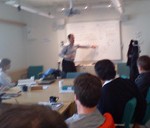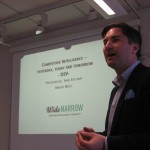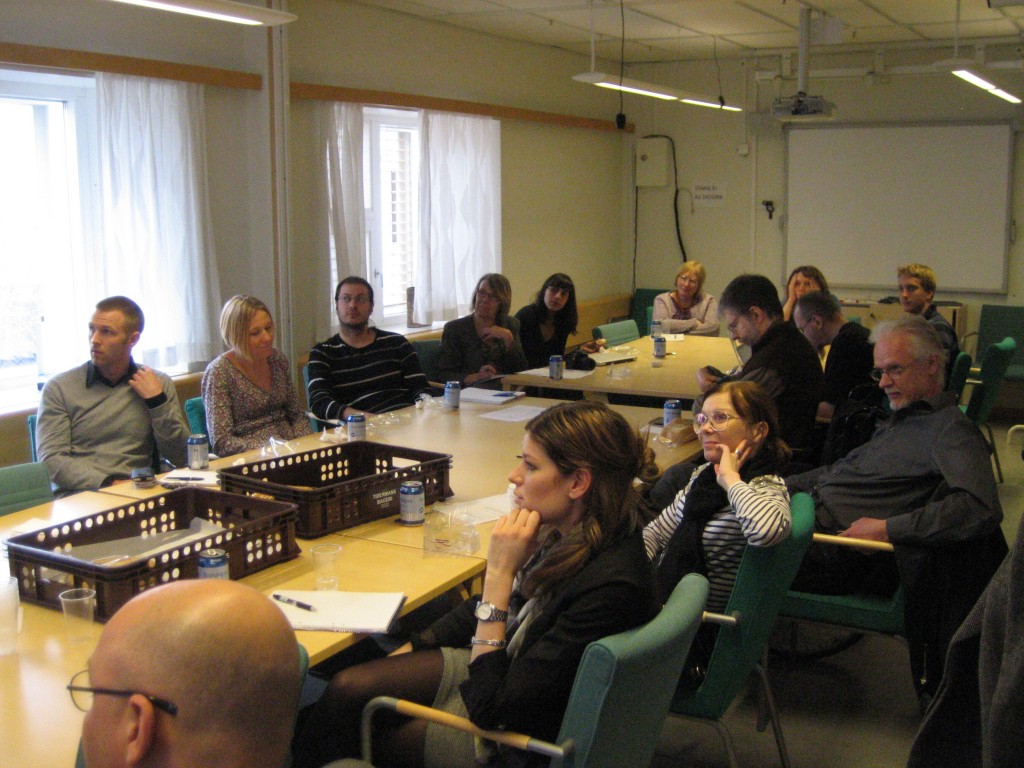We’ve had a paper accepted to the 13th Conference on Artificial Intelligence in Medicine (AIME’11), which this year will be held in Bled, Slovenia (July 2-6). The paper is written by myself, Martin Hassel and Maria Kvist and is titled Diagnosis Code Assignment Support Using Random Indexing of Patient Records – A Qualitative Feasibility Study. We have explored the possibility of using statistical data on co-occurrences of words and assigned diagnosis codes (ICD-10) in coded patient records and applying these (word space) models as a means to provide computer-aided diagnostic coding support.
Paper accepted to the XXIII International Conference of the European Federation for Medical Informatics (MIE 2011)
The paper Factuality Levels of Diagnoses in Swedish Clinical Text which I’ve written together with Hercules Dalianis and Maria Kvist has been accepted to the XXIII International Conference of the European Federation for Medical Informatics (MIE 2011), which will be held in Oslo, Norway 28th–31st August 2011. The paper describes work on an annotation project where clinical diagnoses were annotated for factuality levels, for the purpose of building automated systems for enhanced future information access. The paper will be included in the MEDLINE indexed proceedings, published by IOS Press in Amsterdam.
Research proposal submitted to SSF encompassing 19 MSEK
Professor Henrik Boström and associate professor Lars Asker from System Analysis and associate professor Hercules Dalianis from IT for Health submitted a research proposal with the title High-Performance Data Mining for Drug Effect Detection to SSF (Strategiska stiftelsen) encompassing 19 MSEK and 5 years. University of Borås is co-applicant. Stakeholders are Astra Zeneca, Karolinska University Hospital and Karolinska Institutet, TakeCare – Compugroup Medical as well as Hjärt- och Lungsjukas Riksförbund. The aim of the project is to detect adverse drug reactions based on models and data repositories within the pharmaceutical industry but also on “real” data such as electronic patient records and registries of prescribed drugs, and in the form of globally collected individual case safety reports. The detection will be carried using various data and text mining methods implemented in a parallel computing system for fast and efficient processing. The outcome of the project will be faster drug development, less adverse drug reactions and better treatment of patients.
Papers accepted for publication in the proceedings of Americas Conference on Information Systems (AMCIS 2011), Detroit, USA, 4-7 August, 2011
The Americas Conference on Information Systems (AMCIS 2011) that in this year will be held in Detroit, USA from 4-7 August, 2011 (http://amcis2011.aisnet.org/) is a top ranked conference in Information Systems area according to The Australian Government’s Excellence in Research project (ERA): http://lamp.infosys.deakin.edu.au/era/?page=cfordet10&selfor=0806
In this year three papers written by the members of IT Management group were accepted for publication (two as papers and one as poster) in the proceedings of AMCIS 2011. The authors of the papers, the title and the abstract are included below.
The first paper is written by Edephonce Nfuka and Lazar Rusu, and is entitled: “Critical Success Factors Framework for Implementing Effective IT Governance in Public Sector Organizations in a Developing Country”.
Abstract
Several frameworks for IT governance exist with various approaches like for example COBIT or ITIL. However neither of these frameworks has looked on implementing an effective IT governance from the point of view of Critical Success Factors (CSFs). Therefore in this paper, we have specifically addressed this gap by developing a framework of CSFs for implementing effective IT governance (CEITG) in public sector organizations in a developing country like Tanzania. This was achieved using four previous studies in this environment as a basis, together with interviews with 43 IT and business people from 25 public sector organizations, 6 industry/academic experts and finally through a case study in an organization in this environment during CEITG development and evaluation. The results of this research is a high level and holistic view framework based on CSFs and the activities in each IT governance focus area that should be considered by IT and business management personnel in the process of implementing effective IT governance in public sector organizations in Tanzania.
The second paper is written by Anayanci Lopez, Lazar Rusu and Paul Johannesson, and is entitled ”Construction of a Maturity Model for Analyzing Strategic IT Service Management”.
Abstract
The paper presents the construction of a maturity model for analyzing the strategic IT service management (ITSM) process of internal IT service provider’s in early growth stages. This model is presented as an alternative tool for improving the understanding, from an IT service management perspective, of: (i) the strategic IT processes/practices in an IT organization, and (ii) facilitates the improvement task of such IT organization. The model construction is done by using a combination of best practices of IT service management and IT governance together with characteristics specific to the object under analysis, e.g. internal IT service providers, municipal governments standards. The model uses a wider scope for strategic ITSM which facilitates its applicability in IT organizations in early growth stages, giving a practical value to the model. Furthermore this model is designed to be used independently or as a complementary component of a method for analyzing IT service strategy presented in a previous study.
The third paper is written by Georg Hodosi and Lazar Rusu, and is entitled “A Risk Based View of Influential Factors in IT Outsourcing Relationship for Large Swedish Companies”.
Abstract
Today IT Outsourcing (ITO) is well spread among the large Swedish companies and this trend will continue in the near years. Our focus in this research is a service buyer company who needs a well working relation with its ITO supplier for fixing: emergent issues, daily operation and changes that have not been foreseen. In the last years, an increasing attention has been paid to improving ITO relationship. In the review of the research literature we have not found any studies about Influential Factors (IFs) that could improve ITO relationship in large Swedish companies, nor about how risks factors are interrelated to the ITO relationship. Therefore this research has addressed this problem by providing the IFs that could improve ITO relationship in large Swedish companies and could help the service buyers companies’ to focus on these IFs. Additionally, we have developed a framework that could support the ITO decision makers in both mitigating the risks and the improvement of the ITO relationship.
17.000 appar om hälsa – rapport från Vitalis 2011
På Vitalismässan 2011 i Göteborg presenterades det senaste om IT för hälsa. Bland annat lärde jag mig att det nu finns 17.000 appar om hälsa för smartphones i världen. Allt från joggingprogram till mätning av blodsockervärden. En del av dem kan interagera med vårdens journalsystem. Detta illustrerar problemet med överföring av data mellan olika system och behovet av standards.
Många presentationer handlade om nationell IT-struktur för hälsa. Socialstyrelsen har kommit i mål med sina projekt Nationellt fackspråk och Nationell informationsstruktur för vård och omsorg. Arkitekturledningen, en samverkan mellan Socialstyrelse, SKL och CeHis, ger en bild av hur IT-Vård-Sverige ska kommunicera bl. a. för uppbyggnaden av de nationella kvalitetsregistren för olika sjukdomar. Olika standards för datautbyte mellan system utarbetas. Detta blir alltmer nödvändigt också då privatisering med många vårdgivare medför fragmentering av vårdprocessen och information behöver överföras mellan olika system.
Mer strukturerade patientjournaler (med kryssrutor) är att vänta, den fria texten är hotad då man inte anser sig ha tillräckligt bra verktyg för att kunna extrahera data och överföra till kvalitetsregistren. Översättningen av Snomed CT är klar och ska mappas in i olika klassifikationer och interfaces för likriktad begreppsanvändning i Sverige. Dock leker myndigheterna Svarte Petter och ingen vill sitta med mandatet att fatta det slutgiltiga beslutet om att det ska införas, vilket IT-leverantörerna inväntar.
Vård IT-rapporten 2010 presenterades, en användarundersökning om vårdpersonalens erfarenheter av IT i vården, som är en del av Vinnovas projekt eHälsorapporten 2010. Problemen med journalsystemen i vården handlar mycket om dålig översikt pga överdokumentation. Dagens system ger dålig återkoppling på egna åtgärder, vilket hämmar lärandet. Slutsatsen är att användare måste vara med i processen då system skapas. De fyra stora vårdfacken har formulerat gemensamma krav på Nationell eHälsa.
Socialdepartementets representant talade om patientmedverkan och ett skifte med ökad tillgänglighet till vårdinstanser och journaltexter via nätet.
En samlad framtidsbild av olika talare har patienten som en aktiv aktör i vården, det är slut med ”tacksamhetsgenerationen” och nu kommer IT-generationen som sköter sin hälsa med hjälp av interaktiva program för bantning, rökstopp och fobiträning, och där den klassiska vården konsulteras i korta episoder men helt på patientens villkor och under marknadskrafternas lagar.
En studie visade att 40 % av patientpopulationen för en viss region saknar datorer i hemmet, så jag befarar att de stora ekonomiska satsningarna på vård via IT också kommer att medföra en ökad segregering.
EnRiMa Workshop held in Stockholm
The EnRiMa FP7 project held a two-day workshop at DSV April 11-12. Project partners from Austria, Norway, Spain and Great Britain discussed the upcoming decision support system that will support minimizing the energy consumption of public buildings. The project is now at a stage where more detailed requirements for the system will be described. Present from DSV we re Janis Stirna, Martin Henkel, Naghmeh Aghaee, Peter Majlender and Rodolfo Candia.
re Janis Stirna, Martin Henkel, Naghmeh Aghaee, Peter Majlender and Rodolfo Candia.
For more information on the EnRiMa project, go to http://www.enrima-project.eu/
Scientific presentation by Stewart Kowalski at NISlab
IS/IT systems around the world are being attacked by both external and internal attackers. Organizations in the public and private sectors are investing more capital and operational resources to deal with these attacks. However without an adequate model of the attackers it is difficult to measure how effective and efficient the use of these resources will be in the long run. It can be that the IS/IT security measures that are being implemented only turn the current situation into a never ending cat and mouse game where the mouse always finds new ways to keep the cat busy.
On Tuesday 12/4/2011 Stewart Kowalski gave a presentation “Modeling the Attacker” in the Norwegian Information Security laboratory (NISlab) which is the information security group at Gjøvik University College, Norway. In his lecture Stewart Kowalski presented his past and current research in modeling the attackers of IS/IT systems using a socio-technical engineering approach.
IS-Seminarie: Strategisk omvärldsanalys som beslutstöd
 Onsdagen den 6 april höll Anders Bretz från Wide Narrow en presentation om strategisk omvärldsanalys här på DSV.
Onsdagen den 6 april höll Anders Bretz från Wide Narrow en presentation om strategisk omvärldsanalys här på DSV.
Wide Narrow hjälper organisationer att identifiera och analysera externa faktorer som kan påverka deras affärsverksamhet.
Anders visade hur kombinationen av ett grundligt kravspecificerade med kunden om visa viktiga mät- och måttpunkter och en egen utveckling av ett webbaserat omvärldsbebakningssystem gör det möjligt för kunden att, med hjälp av interna resurser, producera faktabaserade beslutsstöd baserat på kunskap om förändringar i omvärlden.
Wide narrow har betygsatt över 300 svenska företags arbete med omvärldsanalys och kommit fram till att cirka 20 procent av företagen har en strukturerad omvärldsanalys.
Vi fick även se ett exempel på hur planering och implementering av en process för omvärldsanalys går till.
Läs mer om Wide Narrow>>
